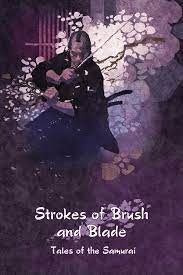
Strokes of Brush and Blade: Tales of the Samurai. Edited by Janice Lee; and Forty-seven Samurai: A Tale of Vengeance and Death in Haiku and Letters by Hiroaki Sato – reviewed by Arthur O'Keefe
Strokes of Brush and Blade: Tales of the Samurai. Edited by Janice Lee. Kumamoto: Kurodahan Press, 315 pages, ¥2200 (paper).
Forty-seven Samurai: A Tale of Vengeance and Death in Haiku and Letters by Hiroaki Sato. Berkeley: Stone Bridge Press, 264 pages, ¥2276 (paper).
The samurai is iconic to Japanese history. The two titles considered herein provide the reader with engaging depictions of an ancient warrior culture.

Strokes of Brush and Blade: Tales of the Samurai is a collection of historical short fiction by modern Japanese authors. Most stories are set in the latter part of the Edo Period (1603-1868), when the samurai were Japan’s entrenched elite. The provision of historical background at times makes some stories read like historical essays, but in general, progression and pace were not overly affected.
A theme that stands out is the conflict between obligation and desire, such as in Kamiya Masanari’s “Left-hand Man,” which fictionalizes Maeda Toshiie, a general of 16th century warlord Oda Nobunaga. Toshiie has killed another vassal who had blatantly stolen a treasured kōgai (hairpin) from him and then mocked him. Now persona non grata, Toshiie tries to win back Nobunaga’s favor by taking enemy heads despite being banned from battle. In “The Three Retirees of Komachi Row House” by Niimi Ken, a former Edo constable is torn between wanting to enjoy his relaxing but unexciting retirement and his desire to investigate a suspected human trafficking ring. In Akiyama Kano’s “Izō,” the title character is a teenage boy who, naturally brilliant at swordplay, refuses the discipline of formal training.
While bushido—the samurai code of conduct—had its own distinct elements, this internal struggle of personal desire versus duty is a universal dilemma, making the characters feel real. Bridging the chasm of time and culture, we see something of ourselves in those depicted.

Forty-seven Samurai: A Tale of Vengeance and Death in Haiku and Letters was written in English by Hiroaki Sato, prolific Japanese author and translator. Per the title, Sato provides insights on an iconic event in Japan’s history, in part through poems and letters written by those involved. The story of these forty-seven samurai is so famous that it has long been a staple of Japanese theater, cinema, and television.
In 1701 Asano Naganori, Lord of the Akō Domain (part of modern Hyogo), attacked and wounded Kira Yoshinaka, Lieutenant Governor of Kōzuke (modern-day Gunma) over a perceived insult. The attack took place within Edo Castle, seat of the shogunate. Asano’s action was deemed unacceptable, and the shogun sentenced him to death by seppuku—ritual suicide. His lands were expropriated, and the warriors who had served under him were now rōnin—masterless samurai, a condition often synonymous with poverty. In 1702, a band of these rōnin, holding Kira responsible for the death of their lord, attacked Kira’s residence in Edo, killing him in revenge and presenting his head at Asano’s grave. Eventually, the rōnin joined their master in death, themselves condemned to seppuku for this action.
The book illustrates the ambiguity and mystery surrounding this incident. For example, the forty-seven rōnin’s act was legally condemned yet deemed morally laudable, and they were kept in luxurious custody while awaiting their fate; Asano’s motive in attacking Kira is not clearly known, but there is evidence that it was related to a refusal on Asano’s part to pay Kira a bribe; the participation of one member of the forty-seven in the raid has never been firmly established: it is likely that there were forty-six rather than forty-seven attackers. On this latter point, Sato states: “In this account we will stay with forty-seven, not because those who argue for forty-six are wrong, but because the participants themselves used the number, and, also, for the sake of tradition” (31).
Another point possibly unknown to the Western reader is that in Edo Japan, to kill for revenge was legally sanctioned under certain conditions, even for commoners. One needed official approval from the authorities. However, Sato notes evidence that less than 1% of such attempts were successful. Back then, it wasn’t difficult for one’s target to disappear.
The aesthetic value of the poems alone makes this book worth reading. Among them are those of Onodera Jūnai, one of the forty-seven, who included them in letters to his wife as he traveled toward Edo from Kyoto:
Rising to part with you this morn to cross the Kamo River
the fog from its water stays around my heart
Okiwakare kesa uchiwataru Kamogawa no
mizu no kefuri ha mune ni tachisou
Especially poignant are the jisei, or farewell to the world poems written just before seppuku, such as this one by another of the forty-seven, Ōtaka Gengo:
A house there’ll be to sip tea on plum blossoms on Mt. Death
Ume de nomu chaya mo arubeshi Shide no Yama
This would be a valuable volume for the student of Edo period politics and society, or for anyone with a keen interest in a look at the life of samurai beyond the image of popular culture. Well-executed and a cut above.
— Arthur O’Keefe
